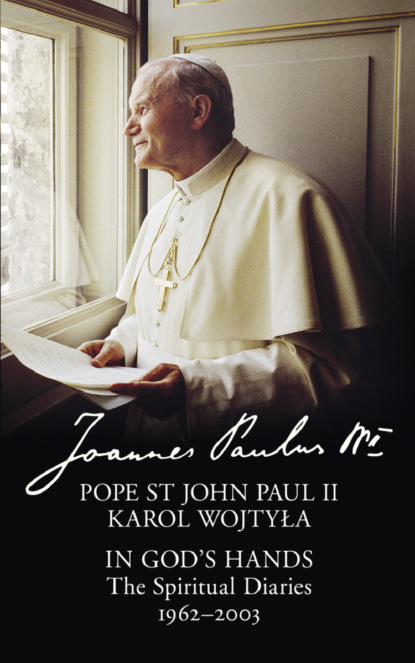По всем вопросам обращайтесь на: info@litportal.ru
(©) 2003-2024.
✖
In God’s Hands: The Spiritual Diaries of Pope St John Paul II
Автор
Год написания книги
2019
Настройки чтения
Размер шрифта
Высота строк
Поля
The Lord God allows for this in order to make our hope grow. Stabat Mater – stabat episcopus sub Cruce Christi [the Mother stood – the bishop stood under Christ’s cross].
Do we live with hope? Do we find support essentially and exclusively in God’s grace? In what mood do people go back after meeting us? If they stand, inspired by the bishop’s optimism, we have fulfilled our service to hope. ‘Grant me, Mother, Your hope, and fill my heart with Your hope’ (nostra conversatio in coelis est [our citizenship is in heaven]).
Nothing can threaten us, neither Satan, nor the world, nor sin – if there is Christ’s power in us in the same way it is in Mary.
And during this retreat God’s love has been poured into our hearts, as it was into Mary’s, by the Holy Spirit.
1–3 November [probably 1964]
Visiting the shrines: Montèvergine – S. Giovanni Rotondo – S. Michele in Gargano – Lanciano (!)
4 November: Memorial of St Charles Borromeo
At the Felician Sisters’ – quaedam reasumptio [a certain conclusion]
17–20 [August] 1965 (#ulink_8a810f68-6a79-599f-aacb-7386617346f5) Retreat in Tyniec Topic: Justification, theological virtues
17 August
Holy Mass read on the Memorial of St Hyacinth of Poland (OP). After the arrival in Tyniec: Vespers; Adoration; Compline
18 August
Morning prayers [illegible]; (Rosary); Lauds; Holy Mass; Thanksgiving; Matins; Prime; Act of Consecration to the Blessed Virgin Mary
Meditation: Referring back to the retreat of 1963, I wish to expand on the topic of ‘justification’. I find this topic academically (theologically) appealing and at the same time internally, personally important. The topic develops into a reflection on theological virtues, i.e. divine virtues.
Faith. The catechism’s definition: ‘to accept as true all that God has revealed to us and that holy Church proposes for our belief’
can be interpreted and even experienced in different ways. The intellectualist (ideological) interpretation is different from the personalist (charitological) interpretation. It is not only about the sum of truths (propositions) which the mind accepts through the authority of ‘God who reveals them’ – and more directly: Christ, the Church (cf. motiva credibilitatis [compare motives of credibility]).
It is about the specific supernatural relationship of man – a person – with the personal God (Trinitas SS [the Holy Trinity]). The nearer foundation of this relationship is the mind (reason). The proper subject matter of this human faculty is truth. Faith is a readiness, indeed, it is an act of reason which is ready to accept God’s truth as its own truth. Communicatio in veritate cum Deo [Communion with God in truth]. It is probably the highest act – one of the highest acts – in a relationship of a person to a person. This readiness to communicate in truth becomes, in a particular way, renewed through revelation, and in general with its help (in its extension lies theology). Faith consists in the acceptance of revelation, but it is possible thanks to the readiness of the mind mentioned above, which revelation takes for granted and simultaneously makes fully possible.
The Way of the Cross: main theme ‘viator – comprehensor’ [‘wayfarer – comprehensor’];
The Little Hours; Reading the schemas; Vespers for Wednesday
Adoration: it somehow provides me with topics for the afternoon meditation
Meditation on practical issues: dialogue, the Church of dialogue, others separately
Matins; Spiritual reading; Compline
19 August
Lauds; Prime (communal); Holy Mass with petitionary prayers before and after; Writing pastoral texts
Meditation: To continue yesterday’s topic, it must be first observed that faith would require a much broader analysis, including the issue of atheism (unbelief) and the attitude to it. (The Church of dialogue is in fact the object of the virtue of hope.) Hope itself is a very rich and complex virtue. It is not possible to conduct its multidimensional analysis right now. Just some dimensions. In hope there is something of faith and something of charity. Fundamentally, it is the wish for what God offers us in revelation, which we mentally accept through faith. It is then our wish for and choice of God and the entire world of supernatural goods. There is a certain personalist dimension in this; hope turns us towards God as the aim, hope is the wish for or even the desire of ‘the everlasting hills’.
But it is here that its second dimension is revealed, and it could be called the ‘dimension of strength’. Will I manage? A certain evaluation of one’s own strength in relation to the aim. And after this evaluation, trust: God Himself will give me strength for that. ‘Deus adiuvabit’ [‘God will help’]. So the relationship of a person to the Person in hope has two dimensions: first, the readiness to wish for that which God wishes for (through this dimension hope frees us from ideological negativism and the senselessness of life), and, second, trust (through this dimension hope frees us from despair). The first dimension takes place thanks to the second, and vice versa. And an essential and indispensable element of the justification of man before God is realised through the entire virtue of hope in both its dimensions. Hope is an attitude of the human being towards God (a person towards the Person) in which one is ‘just’, i.e. in the right position towards the one who is God. This attitude results from grace and simultaneously leads to it. (NB personalist and revealed morality in some way consists of analysing such attitudes.)
Here also ‘timor’ [‘fear’].
The virtue of hope turns towards eternity and temporality at the same time. God, helping us reach eternity in temporality, simultaneously helps us fulfil His plan, which is focused on eternity, in temporality. It is all about making this plan of His ours. Hope does not accept fiction nor ‘substitutes’. However, it permeates our various temporal tasks, which we undertake through God’s will. Without hope – without putting trust in Him and having confidence that He will help – it would definitely be impossible.
The Way of the Cross: Main theme: salvation is linked to hardship – hope takes this into account too.
The Little Hours; Reading schema XIII;
Vespers for Thursday; Rosary continued
Adoratio SS-mi, ubi Xristus tamquam fons et stabilis mensura vitae humanae praesens adest [Adoration of the Holy Sacrament, in which Christ is present as the fount and permanent measure of human life]
Afternoon meditation on practical issues, on these separately; Anticipated Matins
Reading (on the priesthood of laity by Father Przybylski)
Compline; Holy Hour – priesthood as the main topic – for priests and vocations
20 August: Memorial of St Bernard
Lauds; Prime; Rosary; Prayers (preparation for Holy Mass); Holy Mass; Thanksgiving; Writing texts related to 5 September and the following days
Meditation: Love, the virtue of charity, is an even broader topic than the previous one. First of all, the fact that God is love puts it above everything, and makes it the centre towards which all participation gravitates. Charity is the ‘fulfilment of justification’. It is even more than ‘plenitudo legis’ [‘the fulfilling of the law’].
Through love the fullest and the most mature contact of a person with the Person can be established – the contact that faith and hope have already foregrounded. It seems that both these virtues share something with charity, they prepare one for it and lead one towards it. It is not surprising that charity cannot exist without them (though they can exist without charity). At the same time, the essence of charity exceeds what faith and hope are by themselves. There is more in charity – and through this ‘more’ it remains incomparable to the other two. It is difficult to grasp this ‘more’. It seems that charity is always responsible for the union with a person that takes place within that which is good, and the union with that which is good that takes place in a person. Its nature is, in a sense, bipolar, being simultaneously ‘personalist’ and ‘axiological’. It has to be love ‘above all’ for God, who is the fullness of good – and for creatures, specifically people, according to the measure of good they represent. Love is not bound to a person in a way that would make it impossible for it to go beyond that person (where it is possible) towards good. At the same time, a proper relation between good and charity makes it always possible to turn love towards other people – not only one specific person, but people in general. Love is characterised by the properties which St Paul wrote about (1 Cor. 13). Its essence is beyond properties and it is such a participation in God that it fills all eternity.
The Way of the Cross: Expanding on these reflections, e.g. Station II: ‘ubi amatur, iam non laboratur, et si laboratur, etiam labor amatur’ [‘in love, there is no hardship; even in hardship, the hardship is loved’]; Station VIII: the strength of love lies also in the identification of that which is not love – even though it appears to be – for what it is.
The Little Hours; Adoration (Words of Our Lord Jesus Christ on the cross); Rosary; Vespers; Afternoon meditation on practical issues (separately)
Continuation: 26 September, 28 September [probably 1965]
7/8 November: Dies recol. [Reflection days]
Main thoughts: (a) participatio in sacerdotio Christi – in summo sacerdotio [participation in Christ’s priesthood – in the highest priesthood]; (b) priesthood and the days of death (1–2 November) coincide in my life in a significant way; (c) then thoughts ‘de redemptione’ [‘of redemption’] come back (redemptio – redemption = the restoration of full worth to man and creatures in general); (d) a supplement to the meditation on theological virtues: charity is a participation in the very person, and differs from faith and hope in that it leads to a participation in a person, thus, a union; (e) just like at the retreat, also here one feels an eagerness to complete tasks (which at this stage I have put in some order).
[19]64 (65?) (#ulink_525e6daa-2b58-5896-bcd5-6057ca8f27a0)
7/8 November
This day was a kind of anticipation of the retreat day (intertwined with other activities). The key thoughts of the day: (1) the reality of the Most Holy Trinity (preface); (2) the issue of ‘meaning – service’.
2 December
Matins; Holy Mass; Lauds; Prime
Meditation 1: The Church as the means to the end, which is God Himself: the union of persons–souls with Him. Simultaneously, the same Church as Sponsa [Bride]: the divine order is the order of love.











